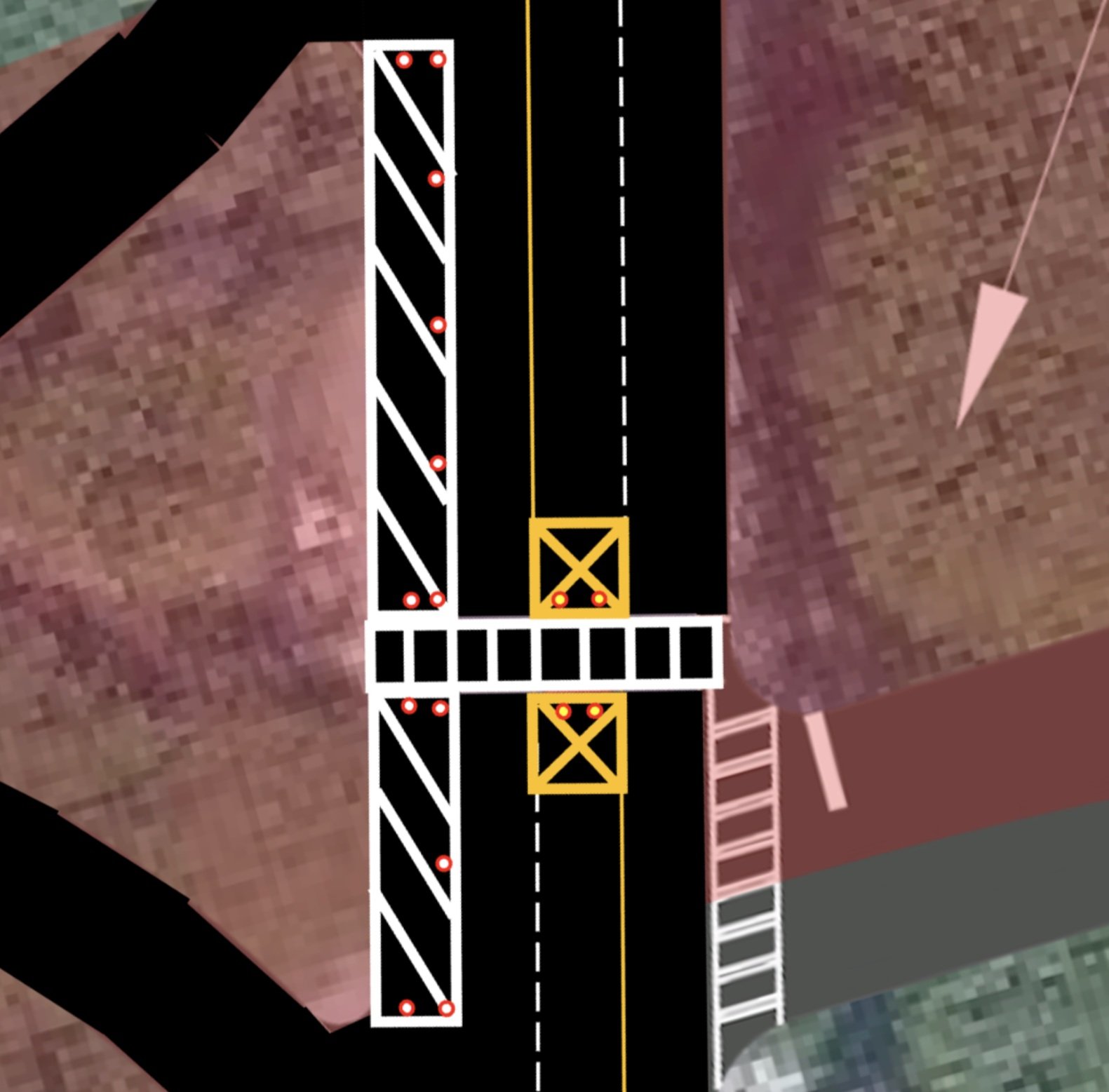Atlanta is covered with “crosswalks” across multi-lane roads. SUVs race by with no concern for timid pedestrians who are unwilling to play chicken with speeding 4,000 pound vehicles. A particularly dangerous crosswalk is the Monroe Drive crossing at Greenwood Avenue in Midtown.
This 44’ crosswalk is in the middle of Midtown’s longest section of road between stop lights. Car parts and smashed telephone poles regularly decorate the sides of this half mile drag strip. Making matters worse, drivers in both directions know that on the other side of the crosswalk, the road transitions from one to two lanes. So if a lucky pedestrian gets a driver to stop for them to cross, a driver approaching the stopped car would regularly speed up, illegally cross over the double yellow and aim for the free lane on the other side of the crosswalk. The pedestrian would never know what hit them.
“The pedestrian would never know what hit them.”
ATLDOT 2017 Design
This obvious safety concern is why this crossing tops the Midtown Neighbors’ Association’s (MNA) infrastructure priority list. In 2017, the Atlanta Department of Transportation (ATLDOT) also recognized this hazard and shared a safer design of the crosswalk with a lane reduction to 1 lane in either direction and a concrete pedestrian haven in the middle of the crossing as part of the Monroe Complete Street Project. This new design reduces pedestrians’ exposure to cars by 50% (22 feet) without impacting cars traveling on Monroe. Since then MNA has worked with Council Members (Alex Wan and Amir Farokhi) and ATLDOT to further increase the safety of this design with a Pedestrian Hybrid Beacon (PHB) that creates a temporary traffic stop light. Unfortunately this much safer crosswalk along with the Monroe Complete Street Project are still in the design phase set to be complete in September 2028.
“$1,000 worth of paint and flex posts from Home Depot that could be installed in less than 2 hours”
Instead of waiting many years for the preconstruction, procurement, and construction to complete, MNA proposed a short-term fix that simulates ATLDOT’s design using $1,000 worth of flex posts and paint from Home Depot that could be installed in less than two hours.
This kind of low-cost, short-term project was not possible before 2020, when (after being pushed by PropelATL) ATLDOT and the Department of City Planning (DCP) created the Tactical Urbanism Program to empower neighborhood groups like MNA to lead, fund and implement design changes on our streets through project review and approval from the city.
Through the Tactical Urbanism program, MNA worked with the ATLDOT for 5 months to:
Refine designs,
Create safe installation and maintenance plans,
Find and secure the unique commercial liability insurance required (only one company has this insurance),
Gain support from immediately adjacent neighbors through direct outreach,
Gain support from the neighborhood at large through open committee and community meetings culminating in a vote by the MNA Board, and
Convince city council members who provided letters of support.
Through this process, concerns were shared about increasing car traffic and the ability of drivers, particularly those of large vehicles like school buses, to make turns at the intersection. These concerns were eased because tactical urbanism projects are only temporary and could be removed at any time if they don't work out.
“50% reduction in pedestrian exposure to cars and a significant increase in visibility”
The result is one of the ATLDOT Tactical Urbanism program’s most impactful projects. The 50% reduction in pedestrian exposure to cars is still achieved and vehicle travel is not negatively impacted. Pedestrians only have to look for a break in traffic in the nearest lane then cross to the pedestrian haven in the middle of the road and wait for a break in traffic in the opposite direction. No more surprise vehicles coming on the wrong side of the road. Drivers are also more willing to stop because both the pedestrian and the crosswalk are more visible.
“One of the Tactical Urbanism program’s most impactful projects”
This project is a great example of how ATLDOT’s Tactical Urbanism program allows communities to come together to enhance the safety and livability of their streets, and not necessarily have to wait years to see improvements from larger infrastructure projects. ATLDOT and the community can experience a version of the future design and make modifications if needed.
MNA raised enough money from the community to purchase the required commercial liability insurance and buy the materials needed. This insurance covers MNA for any tactical urbanism project which will greatly reduce the cost of future projects.
Sharing
In an effort to help other communities learn from our experience, here is MNA’s detailed tactical urbanism presentation and the steps we went through. Anyone can donate to the maintenance of this project and towards other Midtown tactical urbanism projects through the MNA’s donation website (select tactical urbanism from the “How should we direct your donation?” dropdown). Finally, please reach out to infrastructure@midtownatlanta.org if you have ideas for a project or if you are interested in bringing tactical urbanism to your City of Atlanta neighborhood.












